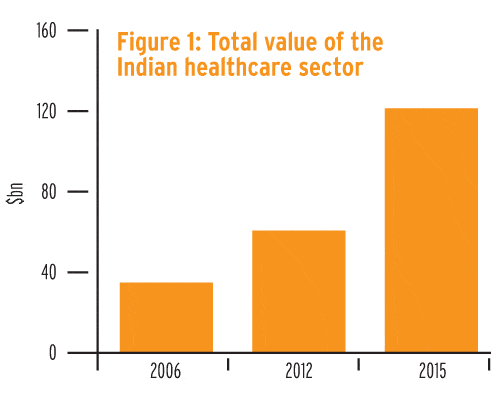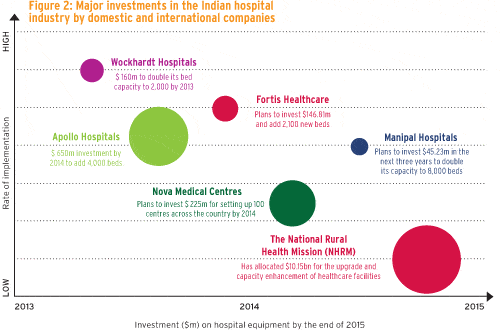
The Indian healthcare sector provides a lucrative growth avenue for companies already operating in the region and for new entrants, particularly diagnostic device manufacturers, pharmaceutical companies and health insurance providers.
The total Indian healthcare sector today is worth $65bn and is projected to reach $100bn by 2015 (see Figure 1 below).

Within this, the diagnostic and medical equipment segment makes up 5 per cent of the total market, having experienced growth rates of 15-20 per cent over the past few years, and anticipating further growth to $5bn by 2015. This represents a massive opportunity for medical diagnostic manufacturers, and as there are several areas that still need significant development, growth is estimated to continue at this rate for another decade.
Factors such as the rising prevalence of diseases, medical tourism, improving affluence of patients and increasing penetration of health insurance have contributed substantially in stimulating the demand for diagnostic services in India.
Growing medical tourism
An additional area of revenue for the Indian healthcare system is medical tourism, which has grown significantly from $400m in 2006 to over $1.5bn in 2012 (CAGR of 20.8 per cent).
International organisations are beginning to recognise the potential value of the Indian diagnostics market thanks to the continuing expansion of medical tourism. The country has a level of technological sophistication and infrastructure that will enable it to maintain a strong position in this sector even as other countries such as South Africa, Argentina and Malaysia look to enter the market.
Moreover, the Indian government has undertaken initiatives in the public health sector which focus on improving medical infrastructure and rural health facilities, as well as encouraging foreign direct investment for medical services.
[There is] a massive opportunity for medical diagnostic manufacturers, and several areas that need significant development
One CEO from an international private hospital company said recently: “India currently treats more patients from the western world than any other healthcare destination in Asia. The last decade has seen the private sector power the growth and maturity of the healthcare delivery sector in India.
“Many hospitals in India have achieved JCI (Joint Commission International) accreditation which demonstrates that they meet global standards of healthcare delivery. High-quality, affordable healthcare will continue to make India a favoured medical value destination for patients from the developed and developing world,” he continued.
Several procedures costing thousands of dollars in the US can be undertaken for a fraction of the cost in India, and this is boosting medical tourism in the region. For example, a bone marrow transplant costing $300,000 in the US can be performed for $40,000 in India with comparable facilities and by world class physicians. Similarly, liver transplants costing $250,000 in the US can be performed for $ 30,000 in India.
Growing hospital sector
The hospital industry in India is also growing, and is widely believed to be the ‘next big thing’ in the Indian market by most global healthcare investors. Some of the growth factors for this expansion include: a rise in medical tourism, improving medical insurance systems, an ageing population, increasing lifestyle-related health issues, increasing discretionary income, government initiatives and a focus on models such as the public–private partnership (PPP).
The Indian government has undertaken initiatives in the public health sector that focus on improving medical infrastructure
Leading private hospitals that are currently controlling the country’s healthcare sector include Apollo Hospitals Enterprise, Fortis Healthcare, Wockhardt Hospitals, Max Hospitals, Aravind Eye Hospitals and Manipal Hospitals, among others.
Fortis Healthcare, Apollo and Wockhardt Hospitals are responsible for running approximately 30 hospitals across the subcontinent and are actively seeking international partners to promote medical tourism. Moreover, the increasingly educated and affluent patient population in India is demanding improved health services, to which the corporate hospital groups are responding by providing upgraded healthcare infrastructure (see Figure 2).

(click image for larger graphic)
Growing urbanisation
One of the major driving forces behind the increasing demand for modern healthcare is the migration of citizens from rural areas to urban developments. Consequently, increased investment is being made in hospitals and clinical laboratories. The rapid increase in health awareness among middle and high-income families in India is also leading to a higher demand for preventive healthcare. More than 80 per cent of medical facilities in India are concentrated in urban areas, while 73 per cent of the Indian population is still rural dwelling. Some 90 per cent of patients require primary and/or secondary care, with only 10 per cent needing specialised tertiary care.
As the population increases in size and age in urban areas, the demand for high-value medical diagnostics is growing rapidly. High-value medical diagnostic devices can be split into two categories:
- In vivo diagnostics – MRI, PET, CT-scans
- In vitro diagnostics – diagnostic test devices for IHC, FISH, PCR, q-PCR, MS, sequencing or others.
A recent survey showed that of the total cost of a hospital project, nearly 30 per cent is directed towards high-value medical and/or diagnostic equipment. With the advent of newer technologies, medical equipment is increasingly relied upon to assist healthcare professionals with diagnosis and treatment. Hence, the purchase, maintenance contracts and replacement of medical equipment are an essential and integral part of hospital management.
The rapid increase in health awareness in India … is also leading to a higher demand of preventative healthcare
Prior to the purchase of equipment, a number of factors will be considered by the hospital, such as the requirement for the equipment, how it will be utilised, its purchase price and the ongoing cost of maintenance. The decision is taken in consultation with various people including medical professionals, senior management, biomedical engineers and other stakeholders.
Power of influencers
Those influencing the decision to purchase equipment vary from one institution to another. As in any other public sector organisations around the world, non-private hospitals in India have multiple stakeholders. Physicians and other healthcare practitioners, senior management, procurement and external stakeholders such as suppliers and manufacturers, all play a role in purchasing decisions. The process is slightly less complicated in private hospitals and appears to have fewer key decision makers and influencers.
In today’s highly competitive market, sales personnel have to manage physicians, who in India are very cost conscious, and simultaneously manage the expectations of procurement, the C-suite, nurses and technicians. Many of these stakeholders will have preconceived ideas about different device manufacturers based on their experience, as well as secondary information from their family and friends working in the same field.
With more stakeholders involved in the decision process, each with their own priorities and differing views about any given device, the complexity of the sales process can rise exponentially. This increased complexity translates into a greater time commitment for each account and for that time to be prioritised appropriately.
Additionally, there is a strong bureaucratic system in India, which supports a number of committees including a new product committee and a value analysis committee (VAC) among others.
Such committees serve to lengthen the purchasing decision which in turn, lengthens the buying process. This also means that many of the decisions are made in the absence of the sales representative, allowing him or her little opportunity to influence the decision. Therefore, working with internal champions and stakeholders becomes a critical step in representing new products effectively.
Furthermore, in addition to the multiple decision-makers inside the hospital, there are a number of powerful groups outside in the market. Group Purchasing Organisations (GPOs) contract with suppliers to pool the purchasing power of a consortium of member hospitals, and independent consultants are sometimes employed to identify cost savings.
Partnerships and alliances
In a nutshell, the Indian hospital industry is undergoing significant changes driven by rapid economic growth, attracting increasing amounts of investments from the pharmaceutical and medical device manufacturers overseas.
For medical device manufacturing companies in the global arena, there is considerable potential to increase profit in this region. The significance of growth drivers must be considered while defining sales strategy or conducting financial analyses in the country. For device manufacturers to exploit these opportunities fully, partnering or creating alliances with pharmaceutical companies and corporate hospital groups can be mutually beneficial, providing advantages of size and strength, as well as filling gaps in both companies’ offerings.





